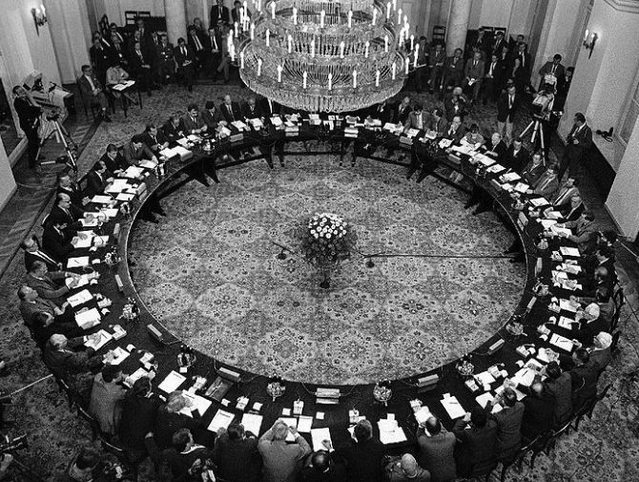On 6 February 1989, the Round Table discussions began. During those negotiations, representatives of the Communist authorities and the Solidarity opposition sought common ground for further action. In large part, they discussed political issues, but not only: they talked as well about the economy, administring justice, ecology, even housing policy. This agreement became possible thanks to the evolution of the situation in Poland as well as in the international arena.
by Tomasz Kozłowski
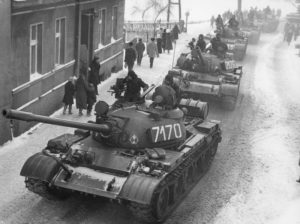
A few years earlier, in 1981, martial law had been imposed in Poland. Thus had the authorities tried to pacify their largest political opponent, the Solidarity Independent Self-governing Labor Union, which included around ten million members (from a population of thirty-five million). From its emergence in 1980, Solidarity was a real political force, threatening not only to the Communist authorities of Poland but also to its allies. The authorities of East Germany, Czechoslovakia and the Soviet Union itself feared that the “Polish plague” could spread across borders and lead to mass protests throughout Central and Eastern Europe.
As a consequence, Gen. Wojciech Jaruzelski, the prime minister of the Polish government and First Secretary of the Polish United Workers’ Party, elected to impose martial law in Poland. This decision was dictated by both the will to preserve power and by pressure from Communist rulers in neighboring states. Hundreds of members of Solidarity unionists and of the political opposition were interned (detained in special camps and prisons). The army and militia pacified demonstrations, with protesters sentenced to imprisonment and dismissed from work. Solidarity was outlawed.
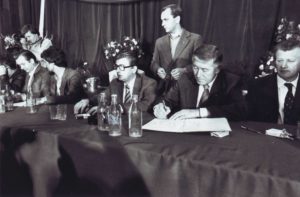
From the left: Marian Jurczyk, chairman of the Inter-Factory Strike Committee (MKS); Marian Juszczuk, deputy chairman of MKS; Kazimierz Barcikowski, deputy Prime Minister; Jarosław Mroczek, member of MKS (standing); Janusz Brych, First Secretary of the PUWP in Szczecin; Stanisław Ozimek, director of Adolf Warski Shipyard in Szczecin (photo by Stefan Cieślak; Creative Commons Uznanie autorstwa 3.0)
Once martial law was in force, Jaruzelski held power in his hands that none of his predecessors had dream of. He assumed total control over the state and the Communist Party. Jaruzelski’s problem, however, was that he was the ruler of a state that was in decline. Poland struggled with repaying debts to the West, as interest rates rose through the 1980s. Although the situation was very bad, it was not exceptional – countries across the entire Communist Bloc struggled with similar problems.
Gradual evolution of Polish and Soviet authorities’ policies was caused primarily by economic factors – their economies were at the brink, and attempts to implement limited reforms were of little avail. This had profound consequences in the international arena. For the inefficient Soviet economy, reinforcing and financially assisting allies were among the largest budgetary burdens. Mikhail Gorbachev advocated changing this policy. In December 1988, Gorbachev officially announced the reduction of Soviet garrisons in East Germany, Czechoslovakia and Hungary. He also announced that Moscow renounced military intervention as a tool in international politics, including among its socialist neighbors. Thus, he ended the so-called Brezhnev Doctrine, which had permitted the Soviet Union and its satellite countries to use armed intervention against any case of “counterrevolution” in one of the Eastern Bloc countries. This basically meant that Moscow was now willing to accept the evolution of political systems in satellite countries, if these did not extend past a certain framework.
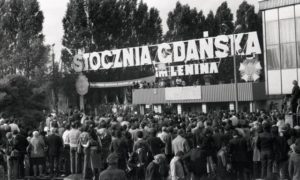
Polish leaders realized that without remodeling the country’s political and economic system, they would not be able to stay in power. Stagnation meant a potential explosion of social dissatisfaction. In the 1980s, more than a million people immigrated from the country, with a very large scale of temporary travels abroad to earn money, as well. Poles saw what life in the West looked like. When this wasn’t with their own eyes, they at least could watch American films. For the authorities, this too was a real threat: VHS tapes, satellite TV and other technological achievements made it easier to spread subversive ideas. Often not even political ones – the world of the West, possible to view thanks to copied video tapes, could be no less of a start for rebellion than the opposition press. In the near future, the greatest threat was coming: the specter of the economy’s final collapse, leading to social revolt.
For years, the political opposition had worked in secret, publishing newspapers and books and organizing demonstrations. The authorities estimated that in the mid-1980s more than thirteen thousand people were involved in opposition activities, and that number was constantly growing. The Security Service, a secret political police, had yet to lose the fight to defend the Communist system, but it certainly was not winning it. In fact, it controlled only opposition elites, and was no longer able to supervise the whole society. The Security Service was effective due to the fact that it was part of the larger system of the authoritarian state, guarded by
the hundreds of thousands of officers and personnel in numerous civil and military services. Their strength was also due to the fact they were permitted to break laws and use violence. However, such measures would be ineffective in the face of mass social protest. The authorities were afraid of a new generation of workers who had not experienced the trauma of martial law.

The darkest scenario for the Communist authorities began to be implemented in 1988. Across the country, again and again, new protests broke out. In the spring, the first wave of strikes took place. Another took pace in the summer, in August. Among others, the Lenin Shipyard in Gdańsk was on strike, where Solidarity had been founded several years earlier. Their leader, Lech Walesa, called on everyone to join the protest. That summer, strikes took place in at least twenty-seven businesses employing a total of almost two hundred thousand people (various occurrences took place in some ninety plants). Although only about fifteen thousand employees actively participated in the protests, this was enough to paralyze work in about 40 percent of these plants. Authorities feared that a third wave of protests could have unpredictable consequences. The deteriorating public mood was alarming – opinion polls indicated that strikes were supported by over 53 percent of respondents (only 37 percent were opposed). Jaruzelski was already convinced that some kind of agreement with the opposition was inevitable.
By August 1988, the authorities were more inclined than ever to negotiate with the opposition. On one hand, the authorities had the “strike” gun pointed at their head. On the other hand, Wałęsa presented his proposal for resolving the political stalemate. Solidarity was to support raising prices and economic reforms in exchange for some compromises and concessions on the side of the authorities. The key demand made by Wałęsa was the re-legalization of the Solidarity union (abolished during martial law) and the legalization of political clubs and associations. On August 31, Wałęsa met with the Minister of Internal Affairs, Jaruzelski’s right-hand man, Gen. Czesław Kiszczak.
Kiszczak had already publicly presented the proposal to hold a Round Table: a meeting of representatives from the authorities, social organizations and Solidarity people – but without Solidarity. A possible outcome from such a discussion could be an agreement that would open the way to the legalization of Solidarity. Kiszczak, as head of the Ministry of Interior Affairs, had outlined four areas of negotiations: electoral regulations for the parliament, establishing the Senate, economic reform and participation of the opposition in political life. The price, however, was high: Wałęsa was to personally call for the strikes to end.
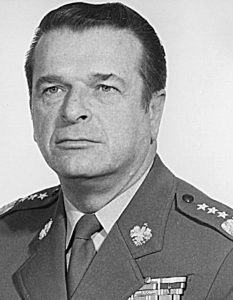
The Solidarity leader and his advisers joined this risky game, with their trustworthiness at stake, earned to date in opposing the Communist authorities. Wałęsa himself recalled years later: “I was not happy, but I could not jump too much. A dozen or so striking factories are not several hundred, as there had been in August 1980.” He explained that ending the strikes could mean for others that he was now the partner in an agreement: “Kiszczak wanted to check if I was credible and whether I was in control of the crowd, in control of the union, and whether I would suppress the strikes.” For many strikers, however, this meant surrender, and in the Lenin Shipyard in Gdańsk, Wałęsa was booed. This pleased Jaruzelski, who emphasized that Solidarity’s leader “came [to talk] to the head of the police, not the other way around.” Moscow was also calmed, confirming that they gave the Polish authorities a free hand in the “experimental introduction of reforms.”
Was the case that Solidarity leaders had misjudged the situation? It seems they did not. Proposing talks with the authorities made deep sense, because Wałęsa and his advisers were planning their activities over the long run. They hoped that a legalized Solidarity would gain strength over time, and that political clubs and associations would form the beginning of civic society. It was social movement of a political nature that gradually, with time, was to amplify pressure on the authorities. The strategy was evolutionary, not revolutionary. It stemmed from a belief among Solidarity leaders that the authorities still held the dominant position and could dictate the terms of the agreement. Furthermore, Wałęsa and his advisers still remembered martial law and feared that the Communists, if backed into a corner, would call tanks into the streets again.
The risk of martial law being imposed again, although unlikely, was not completely out of question. The authorities, for their part, feared both social explosion and Solidarity itself, which was growing in strength. Kiszczak estimated that illegal union structures operated in over two hundred plants. It constituted, therefore, a legitimate oppositional force. In mid-December 1988, the Citizens’ Committee was established by Wałęsa, as Chairman of the Solidarity Independent Self-governing Labor Union, a group of over a hundred leading activists in the union, the opposition and the intellectuals. They would comprise the political and right-hand support for Solidarity during the planned Round Table discussions.
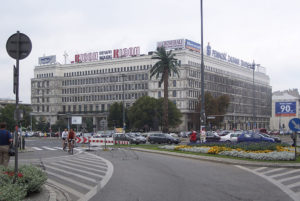
Preparations for the Round Table were prolonged, mainly because the authorities, freed from the threat of strikes, did not have to hurry. Some talks were being held; these, however, did not bring real results. What’s more, further obstacles appeared. First, the authorities were delaying a halt to repressions against the most active strike participants. Second, the government, for economic reasons – or so they said – decided to close the Lenin Shipyard, the birthplace of Solidarity. The union’s leaders found the authorities’ conduct disappointing, but realized that time was on their side. Wałęsa, while meeting with Jaruzelski’s envoys, explained: “We will wait, it will not take long. Maybe it takes three months for the [Party] machine to understand. Three months that will shake the country. And changes will be faster than you expect.” The Polish church’s policy, convinced of the idea of agreement, contributed to the fact that the talks continued. The Polish episcopate, calling for dialogue, announced that “agreement of fundamental values should be the foundation of a basic reform of the state, its structures and national economy.” The bishops moderated informal talks.
As the opposition expected, the situation changed quickly, and went against the authorities. On November 30, 1988, a television debate was broadcast between Wałęsa and Alfred Miodowicz (leader of trade unions supported by the authorities). Unexpectedly for those in charge, the debate turned into Miodowicz’s total defeat. According to 64 percent of respondents, Wałęsa won (1 percent chose Miodowicz). What’s more, research revealed that 73 percent of society supported the legalization of Solidarity and the ideas of national agreement.
In January 1989, a series of initial meetings was held that included Tadeusz Mazowiecki (a key Wałęsa advisors), Stanisław Ciosek (member of the Political Bureau of the Polish United Workers’ Party) and Father Alojzy Orszulik. This group established fundamental issues to be discussed later on. At the end of the month, on January 27, a meeting was held with an enlarged group with Wałęsa and Kiszczak heading two delegations. It was agreed that fifty-six people would take part in the Round Table discussions, including fourteen representatives of the authorities and the opposition, as well as eight activists from Solidarity and other trade unions.
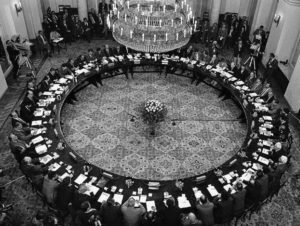
It was agreed that the Round Table talks were to lead to the establishment of a “social contract” – a joint declaration defining the shape of the future system, including upcoming elections, the office of president, economic policy, organization of the judiciary and local government. Solidarity was to receive clear conditions for its re-legalization. The authorities hoped that thanks to establishing this social contract and due to the participation of Solidarity people in elections, opposition politicians would also be held responsible for socially costly reforms. At the meeting on 27 January, Kiszczak insisted: “[after the election] your representatives should pro rata enter the government.” He did not know that as a result of the agreement for the Round Table discussions and for elections, the Communists would lose power and the government would be formed under Tadeusz Mazowiecki, among Wałęsa’s main advisors.
Author: Tomasz Kozłowski – PhD in political sciences, employee of the History Research Office of Institute of National Remembrance
Translation: Alicja Rosé & Alan Lockwood

